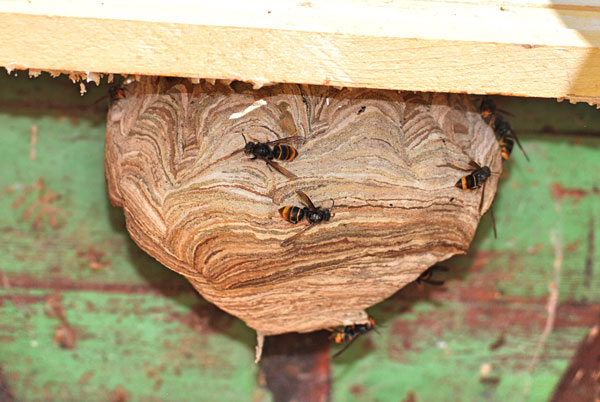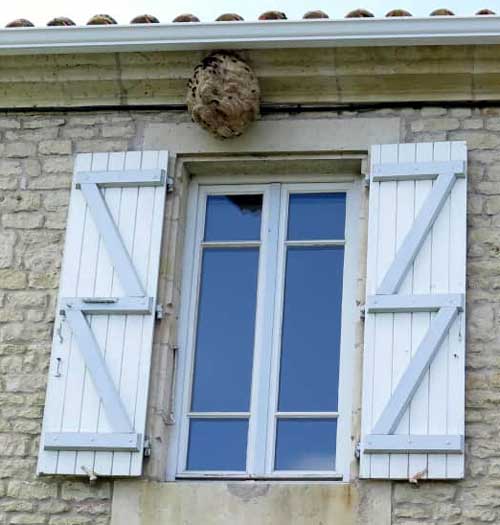Asian Hornet
Vespa velutina nigrithorax
Frelon Asiatique
As its name implies it is not a native to France or Europe
First observed in 2005
the Asian Hornet is thought to have arrived in France from China in 2004, in a container of pottery passing through the port of Bordeaux. Since that date its spread throughout the neighbouring regions has been rapid and often, in the initial stages, follows rivers and other watercourses. In fact it will never be found far from a source of water even if that is only a small pond. As of 2023 they can be found in most of France including the north as well as Italy, Germany, Holland, Belgium, Spain and Portugal, the expansion is relentless and an increasing number have been seen in the UK.
Difficult to confuse with our native hornet
The nest is built using paper mâché made from chewed tree and plant material.
Both types of hornet kill bees
Scale of risks for honey bees:
It's increasingly unclear just what the scale of threat is to Honey bees and it's possibly been overstated given they have been in France since 2005 without any diminution of the number of honey bee colonies. Of course this may be in part due to the continuous commercial production of colonies on both a large and small scale. Most would agree that there is no question about the fact that they do prey on bees at the colony entrance but it's likely that there would need to be a very large Asian Hornet colony in very close proximity to a single (weak?) bee colony to cause serious harm and speculatively even less risk if there were a number of bee colonies together spreading the load. It could be that the risk is greater in the south of France with a longer season for the Hornet colony to get started and grow in size. It remains unclear why some beekeepers never loose colonies to Asian hornets but others do. It's also the case that those that do loose colonies make it known unlike most keepers that don't as they have no reason to say anything.
Photo above is an Asian Hornets nest in my apiary 2014, not visible until the leaves fell in November. READ MORE
It's important to understand that risk to humans from this species is minimal except when and if they consider their nest to be under threat, otherwise they are more timid than the European Hornet and their sting is no worse than that from an ordinary wasp.
Solutions:
Small nests with only a queen at the beginning of the season, (as in the photos at the top), can be destroyed using a powerful aerosol wasp spray with caution preferably at dusk.
Larger nests should be destroyed as a matter of urgency by a competent person that is equipped for the job. As the destruction of their nests and the laws surrounding it is a constantly changing situation you should check with your Mairie but the current situation is that there is no legal obligation on the property owner to have nests destroyed.
Link to réglementation HERE
In late autumn and early spring try to kill as many Queens as possible. They will be easily lured to the scent of honey and I find swatting them with a plastic tennis racket is the easiest method.
Beekeepers with spare hives can also leave some in early spring with frames of used comb with three of them cut back near the top. This will encourage Asian hornets to make their starter nest there where she can easily be dealt with. See photos below




















